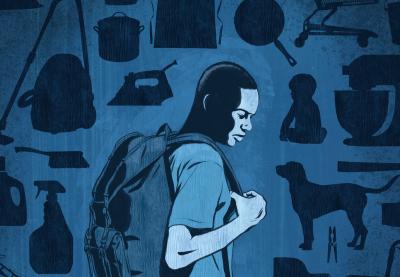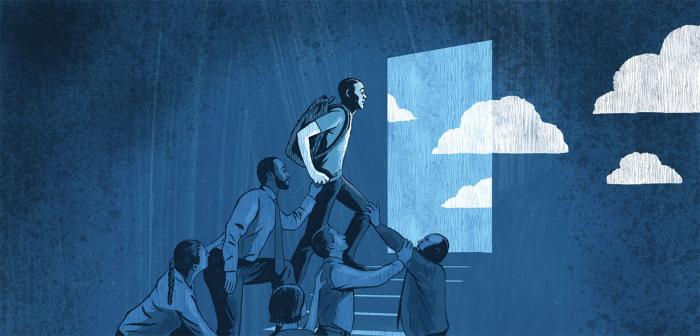Millions of students in the United States leave school each day only to begin their “second shift”: out-of-school responsibilities such as employment, caregiving or parenting, or some combination thereof. For these students, classes are just one of multiple pressures shaping their lives—and the pressures often take a toll. These young people are at risk of disengagement, chronic absenteeism and dropping out altogether.
Educators may not always see the warning signs. Becoming attuned to the circumstances of children and teenagers with heavy out-of-school responsibilities takes training and practice, but it is possible, and the results can change lives. Knowing students’ stories and recognizing their competing pressures is the first step toward connecting them to necessary supports.
A Continuous Balancing Act
“He ended up graduating—but barely.”
Katherine Pastor is a school counselor at Flagstaff High School in Flagstaff, Arizona, and the American School Counselor Association’s 2016 School Counselor of the Year. She recalls a former student named Hudson* who had two jobs at fast-food restaurants to help support his mother and brother. His father had died. On school days, Hudson worked the closing shift, finishing at 1 or 2 a.m., returning home an hour later. Functioning on minimal sleep, he often missed the first hour of school.
“It took between me and the teachers and the administrators to try and help him figure it out,” Pastor says. She and her colleagues pulled Hudson out of one of his electives and set up an individualized study hall in the counseling office. But time was not Hudson’s only constraint; he had to continuously balance working toward a diploma—a personal goal—and working toward a paycheck—an immediate necessity.
Fostering Support at School
Pastor says she usually learns of a student’s out-of-school responsibilities when something negative occurs, such as absenteeism or slipping grades. Once students like Hudson are identified, building trust is critical if their circumstances are to improve.
“Let them understand that those adults at the school are really there to help them and they care about them,” Pastor says. “But until the kid trusts us with knowing that information, then we’re not going to be able to do much for them.”
Frances Esparza, assistant superintendent of the Office of English Language Learners at Boston Public Schools, echoes the importance of supportive classroom teachers. She says, “I would advise them to have high expectations for our students and to know that students are capable of managing their life either as a parent or being employed, as long as they have the support of the school and the teacher.”
In her role as a counselor, Pastor encourages students to speak to their teachers about their home responsibilities; sometimes she asks permission to do so on their behalf. This awareness building does two things: It helps dispel teachers’ assumptions that students are slacking off, and it leads to more supportive adult advocates at school.
In her work with classroom teachers, Pastor also emphasizes relationship building with students with large out-of-school responsibilities. “It’s as simple as standing outside your door and saying hi to every kid that walks in and smiling at them. Or when the student comes to school and you notice that they were absent the other day, instead of saying, ‘Hey man, where you been?’ saying, ‘It’s so great to see you today.’
The Caregiving Youth Project
In Florida, the School District of Palm Beach County and the Caregiving Youth Project (CYP) collaborate to support youth caregivers in grades 6–12, mostly at Title I schools. Youth caregivers are children and teenagers who care for relatives or household members who are elderly or have illnesses and disabilities. The CYP, a program of the American Association of Caregiving Youth, provides free skills-building group sessions, “Lunch and Learn” tables at cafeterias on topics like Alzheimer’s disease and multiple sclerosis, home visits, out-of-school activities and camps, at-home tutoring sessions and more.
Connie Siskowski, founder and president of the American Association of Caregiving Youth, says, “We work with helping them to manage stress, to be able to transform their anger and frustration into feeling valued, because what they do for their family is important not only for their family but also for society.”
One youth caregiver who received support from CYP is AnnMarie. In sixth grade, her grades were dropping and she had behavior and attendance issues. At home, she was frustrated to the point of hitting her mom—prompting a phone call to 911 and the involvement of the juvenile justice system. CYP intervened and worked with AnnMarie to help her manage a heavy responsibility: caring for her mother who was left partially paralyzed after a car accident. From sixth grade through her on-time high school graduation in 2013, AnnMarie had year-round support from CYP.
According to Siskowski, more than 95 percent of CYP students go on to the next grade level and graduate from high school. More than 80 percent continue on to postsecondary education or the military.
Wrap With Care
Nationwide, the types of supports available to “second-shift” students can vary immensely, depending on a school’s ZIP code and budget, as well as the availability of school- and district-based services to meet students’ social, emotional and health needs.
Ideally, students have access to high-quality wraparound services. According to the National Wraparound Initiative, these services require a team-driven process that supports the complex needs of children or youth and their families through individualized plans that are strengths-based, community-based and culturally relevant.
In Boston Public Schools, where Esparza works, wraparound services are a district-wide priority. The Office of English Language Learners works closely with, among others, the Office of Social Emotional Learning and Wellness and the Office of Opportunity and Achievement Gaps. “The three [departments] have been working together to support our older students, especially with staying in school and moving into either vocations or into community colleges,” she says. That ongoing collaboration identifies the specific needs of students, including the ELL students who may also have large out-of-school responsibilities, and seeks to meet them holistically.
Mind the Service Gap
Many students in the United States attend schools where wraparound services are absent and mental health and tutoring resources are stretched thin. Too often, services are limited where they are needed most: in low-income or under-resourced communities.
At Kenwood Academy, a public school on the South Side of Chicago serving grades 7–12, four counselors, one social worker and one school psychologist serve some 1,800 students. Seventy-four percent of Kenwood students come from low-income families, according to the 2014–15 Illinois Report Card.
Kenwood is not an anomaly. According to the U.S. Department of Education Office for Civil Rights, during the 2013–14 academic year, “About 95 percent of high school students have access to at least one school counselor.” But that’s not the complete picture; that same year, the national average student-to-school counselor ratio in public elementary and secondary schools was 491 to 1, according to the American School Counselor Association.
[W]e can help them learn how to advocate for themselves.
Shelby Wyatt, a school counselor at Kenwood and a 2013 finalist for the School Counselor of the Year, says, “Because of the nature of Chicago Public Schools and the budget crunch … teachers have lost jobs; programs have been canceled because of the lack of funding. You need a human body. You need human capital to reach out to even assess, see who needs extra care.”
To fill in a gap in mental health services available to students, Wyatt founded the Kenwood Brotherhood in 2004. It’s a school-based mentoring program for male students, many of whom have multiple competing responsibilities. It’s not funded by Chicago Public Schools but by volunteers, including educators at Kenwood. Aimed at increasing the graduation rate among males, the Brotherhood offers after-school meetings on Fridays, peer-to-peer leadership, activities and enrichment trips, tutoring and homework assistance. Wyatt also has partnerships with graduate schools of counseling, social work and psychology that send interns to Kenwood to counsel and provide mental health checkups to students in the Brotherhood.
One of Wyatt’s former students, Joshua*, was on his caseload and part of the Brotherhood program. Every day, Joshua was responsible for getting his younger sister to and from school. “If we met on Friday after school, he would have to immediately go and get his little sister, bring her back to the high school, hold the Brotherhood meeting and then drive them both all the way out to the South suburbs,” Wyatt says.
Advocate for Equity
Wyatt sees adult advocates as essential to educational equity. “Everyone should have an adult advocate in the building,” he says. At Flagstaff High School in Arizona, Katherine Pastor holds a similar perspective. In her work with students with heavy out-of-school responsibilities, she uses the word advocate all the time.
“We’re the student’s advocate, and they don’t know how to go through this,” she says. “They’ve never done it before, and so they don’t know the right channels sometimes. … [W]e can help them learn how to advocate for themselves.”
Lightening the Load
Regardless of whether their schools offer wraparound services, all educators can advocate for students who carry heavy loads.
Prioritize building trust and strong relationships with students. If a student is struggling, consider what's going on in his life outside of school.
Connect students with school- or district-based services that can support them both academically and at home.
Research and leverage community organizations that can provide students with extra services—counseling, tutoring, childcare and so forth—that your school or district cannot offer.
Get creative about when and where students can access academic support.
Focus conversations on the roadmap to graduation, college and career.
Examine personal and institutional biases about students who are employed, serve as youth caregivers or are parents.
Set high expectations, but demonstrate flexibility and understanding of students' circumstances. Alleviate stress whenever possible.
Recognize that educating a student who is also an employee, caregiver or parent requires cultural competency skills.
Collect and then share building-level facts about students who have heavy out-of-school responsibilities with other educators.
Help students stay academically organized, and, if needed, find ways to provide them with school supplies.
Inform students of their schooling options (flexible schedules, vocational schools, alternative schools, credit recovery and so forth). Be clear that not all options are equal.




0 COMMENTS